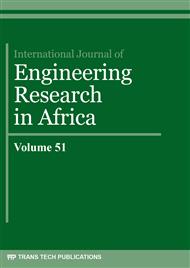[1]
C. S. Agency, Agricultural in figures key findings of 2008/09-2010/11 agricultural samples survey for all sectors and seasons,, pp.21-30, (2012).
Google Scholar
[2]
Z. Yemataw, A. Mekonen, A. Chala, K. Tesfaye, K. Mekonen, D. Studholme, and K. Sharma, Farmers' knowledge and perception of enset xanthomonas wilt in southern ethiopia,, Agricul ture & food security, vol. 6, no. 1, p.62, (2017).
DOI: 10.1186/s40066-017-0146-0
Google Scholar
[3]
S. W. Fanta and S. Neela, A review on nutritional profile of the food from enset: A staple diet for more than 25 per cent population in ethiopia,, Nutrition & Food Science, vol. 49, no. 5, pp.824-843, (2019).
DOI: 10.1108/nfs-11-2018-0306
Google Scholar
[4]
A. Spring, M. Diro, S. A Brandt, E. Tabogie, G. WoldeMichael, J. T. McCabe, M. Shigeta, C. Hiebsch, S. Tesfaye, and G. Yntiso, Tree against hunger: Ensetbased agricultural systems in ethiopia., American Association for the Advancement of science, (1997).
Google Scholar
[5]
G. WeldeMichael, K. Bobosha, G. Blomme, T. Addis, T. Mengesha, and S. Mekonnen, Eval uation of enset clones against enset bacterial wilt,, African Crop Science Journal, vol. 16, no. 1, (2008).
DOI: 10.4314/acsj.v16i1.54348
Google Scholar
[6]
D. Yirgou, J. Bradbury et al., Bacterial wilt of enset (ensete ventricosum) incited by xan thomonas musacearum sp. n., Phytopathology, vol. 58, pp.111-12, (1968).
Google Scholar
[7]
J. Schmidhuber, Deep learning in neural networks: An overview,, Neural networks, vol. 61, pp.85-117, (2015).
DOI: 10.1016/j.neunet.2014.09.003
Google Scholar
[8]
Y. Rikiya, N. Mizuho, K. G. Richard, and K. Togashi, Convolutional neural networks: an overview and application in radiology,, Insights Imaging, vol. 9, pp.611-629, (2018).
DOI: 10.1007/s13244-018-0639-9
Google Scholar
[9]
S. Rahimeto, T. Girma, D. Yohannes, and F. Scwenker, Automatic pectoral muscle removal in mammograms," Under review at Evolving Systems with manuscript number EVOSD1900111, 2019.[10] T. G. Debelee, F. Schwenker, S. Rahimeto, and D. Yohannes, "Evaluation of modified adaptive kmeans segmentation algorithm,, Computational Visual Media, vol. 5, no. 4, pp.347-361, jul (2019).
DOI: 10.1007/s41095-019-0151-2
Google Scholar
[11]
K. P. Ferentinos, Deep learning models for plant disease detection and diagnosis,, Computers and Electronics in Agriculture, vol. 145, pp.311-318, (2018).
DOI: 10.1016/j.compag.2018.01.009
Google Scholar
[12]
G. Ian, B. Yoshua, and C. Aaron, Deep learning., MIT Press, (2016).
Google Scholar
[13]
F. Li, J. Justin, and Y. Serena. (2018) Cs231n: Convolutional neural networks for visual recognition. [Online]. Available: http://cs231n.stanford.edu/index.html.
Google Scholar
[14]
P. Josh and G. Adam, Deep learning a practitioner's approach." O,Reilly Media, (2017).
Google Scholar
[15]
A. Krizhevsky, I. Sutskever, and G. E. Hinton, Imagenet classification with deep convolutional neural networks,, in Advances in neural information processing systems, 2012, pp.1097-1105.
DOI: 10.1145/3065386
Google Scholar
[16]
T. G. Debelee, M. Amirian, A. Ibenthal, G. Palm, and F. Schwenker, Classification of mam mograms using convolutional neural network based feature extraction,, LNICST, vol. 244, pp.89-98, (2018).
DOI: 10.1007/978-3-319-95153-9_9
Google Scholar
[17]
T. G. Debelee, A. Gebreselasie, F. Schwenker, M. Amirian, and D. Yohannes, Classification of mammograms using texture and cnn based extracted features,, Journal of Biomimetics, Bioma terials and Biomedical Engineering, vol. 42, pp.79-97, (2019).
DOI: 10.4028/www.scientific.net/jbbbe.42.79
Google Scholar
[18]
T. G. Debelee, F. Schwenker, A. Ibenthal, and D. Yohannes, Survey of deep learning in breast cancer image analysis,, Evolving Systems, Aug. (2019).
DOI: 10.1007/s12530-019-09297-2
Google Scholar
[19]
C. François, Deep learning with python., Manning Publications, (2017).
Google Scholar
[20]
H. AlHiary, S. BaniAhmad, M. Reyalat, M. Braik, and Z. Alrahamneh, Fast and accurate de tection and classification of plant diseases,, International Journal of Computer Applications, vol. 17, no. 1, pp.31-38, (2011).
DOI: 10.5120/2183-2754
Google Scholar
[21]
D. Al Bashish, M. Braik, and S. BaniAhmad, Detection and classification of leaf diseases us ing kmeansbased segmentation and,, Information Technology Journal, vol. 10, no. 2, pp.267-275, (2011).
DOI: 10.3923/itj.2011.267.275
Google Scholar
[22]
J. Amara, B. Bouaziz, A. Algergawy et al., A deep learningbased approach for banana leaf diseases classification., in BTW (Workshops), 2017, pp.79-88.
Google Scholar
[23]
G. Owomugisha, J. A. Quinn, E. Mwebaze, and J. Lwasa, Automated visionbased diagnosis of banana bacterial wilt disease and black sigatoka disease,, in International Conference on the Use of Mobile ICT in Africa, (2014).
Google Scholar
[24]
B. Tigadi and B. Sharma, Banana plant disease detection and grading using image processing,, Int J Eng Sci, vol. 6512, (2016).
Google Scholar
[25]
S. Bhamare and S. Kulkarni, Detection of black sigatoka on banana tree using image processing techniques,, IOSR Journal of Electronics and Communication Engineering, pp.60-65, (2013).
Google Scholar
[26]
K. Simonyan and A. Zisserman, Very deep convolutional networks for largescale image recog nition,, arXiv preprint arXiv:1409.1556, (2014).
Google Scholar
[27]
C. Szegedy, W. Liu, Y. Jia, P. Sermanet, S. Reed, D. Anguelov, D. Erhan, V. Vanhoucke, and A. Rabinovich, Going deeper with convolutions,, in Proceedings of the IEEE conference on computer vision and pattern recognition, 2015, pp.1-9.
DOI: 10.1109/cvpr.2015.7298594
Google Scholar


